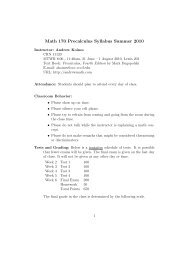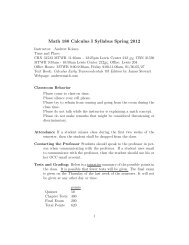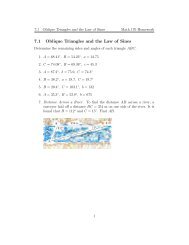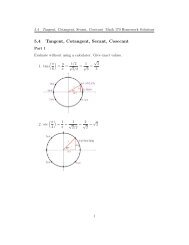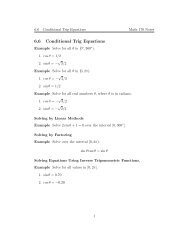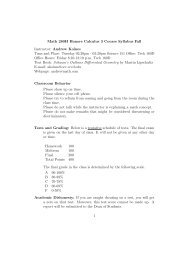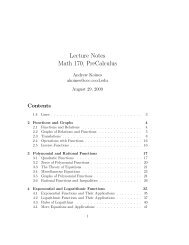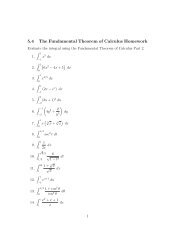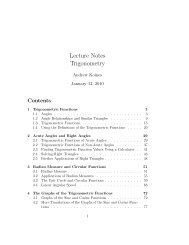§4.12 Orthogonal Sets of Vectors and the Gram-Schmidt Process ...
§4.12 Orthogonal Sets of Vectors and the Gram-Schmidt Process ...
§4.12 Orthogonal Sets of Vectors and the Gram-Schmidt Process ...
Create successful ePaper yourself
Turn your PDF publications into a flip-book with our unique Google optimized e-Paper software.
<strong>§4.12</strong> <strong>Orthogonal</strong> <strong>Sets</strong> <strong>of</strong> <strong>Vectors</strong> <strong>and</strong> <strong>the</strong> <strong>Gram</strong>-<strong>Schmidt</strong><br />
<strong>Process</strong>, HW #1, 3, 15, 17, 19, 23, 25<br />
Definition<br />
Let V be an inner product space.<br />
1. Two vectors u <strong>and</strong> v in V are said to be orthogonal if<br />
〈u, v〉 = 0.<br />
2. A set <strong>of</strong> nonzero vectors {v1, v2, . . . , vk} in V is called an<br />
orthogonal set <strong>of</strong> vectors if 〈vj, vj〉 = 0, whenever i = j.<br />
3. A vector v in V is called a unit vector if v = 1.<br />
4. An orthogonal set <strong>of</strong> unit vectors is called an orthonormal<br />
set <strong>of</strong> vectors. Thus {v1, v2, . . . , vk} in V is an orthonormal<br />
set if <strong>and</strong> only if<br />
◮ 〈vi, vj〉 = 0 whenever i = j.<br />
◮ 〈vi, vi〉 = 1 for all i = 1, 2, . . . , k.
Given a nonzero vector v, <strong>the</strong> vector<br />
u = v<br />
v<br />
will have <strong>the</strong> same direction as v <strong>and</strong> have length 1. It is <strong>the</strong> unit<br />
vector with direction v.
Example<br />
Verify that {(−2, 1, 3, 0), (0, −3, 1, −6), (−2, −4, 0, 2)} is an<br />
orthogonal set <strong>of</strong> vectors in R 4 , <strong>and</strong> use it to construct an<br />
orthogonal set <strong>of</strong> vectors in R 4 .
Example<br />
Verify that f1(x) = 1, f2(x) = sin x, <strong>and</strong> f3(x) = cos x are<br />
orthogonal in C 0 [−π, π], <strong>and</strong> use it to construct an orthogonal set<br />
<strong>of</strong> vectors in C 0 [−π, π].
Definition<br />
A basis {v1, v2, . . . , vn} for a (finite-dimensiona) inner product<br />
space is called an orthogonal basis if 〈vi, vj〉 = 0 whenever i = j,<br />
<strong>and</strong> it is called an orthonormal basis if each vector also has<br />
length 1, i.e., 〈vi, vi〉 = 1 for all i = 1, 2, . . . , n.
Theorem<br />
If {v1, v2, . . . , vk} is an orthogonal set <strong>of</strong> nonzero vectors in an<br />
inner product space V , <strong>the</strong>n {v1, v2, . . . , vk} is linearly<br />
independent.
Theorem<br />
Let V be a finite dimensional inner product space with orthogonal<br />
basis {v1, v2, . . . , vn}. Then any vector v ∈ V may be expressed in<br />
terms <strong>of</strong> <strong>the</strong> basis as<br />
<br />
〈v, v1〉<br />
v =<br />
v12 <br />
v1 +<br />
<br />
〈v, v2〉<br />
v22 <br />
v2 + · · · +<br />
<br />
〈v, vn〉<br />
vn2 <br />
vn
Corollary<br />
Let V be a finite dimensional inner product space with<br />
orthonormal basis {v1, v2, . . . , vn}. Then any vector v ∈ V may be<br />
expressed in terms <strong>of</strong> <strong>the</strong> basis as<br />
v = 〈v, v 1〉v1 + 〈v, v 2〉v2 + · · · + 〈v, v n〉vn
The <strong>Gram</strong>-<strong>Schmidt</strong> <strong>Process</strong><br />
Suppose that we have a set {x1, x2, . . . , xm} <strong>of</strong> linear independent<br />
vectors in an inner product space V . The <strong>Gram</strong>-<strong>Schmidt</strong> process is<br />
a method to construct an orthogonal basis for <strong>the</strong> span <strong>of</strong> <strong>the</strong>se<br />
vectors.
We define <strong>the</strong> orthogonal projection <strong>of</strong> w onto v as<br />
P(w, v) =<br />
〈w, v〉<br />
v 2<br />
The vectors v <strong>and</strong> w − P(w, v) = w −<br />
<br />
v.<br />
<br />
〈w, v〉<br />
v2 <br />
v are orthogonal.
Let v1 = v <strong>and</strong>v2 = w − P(w, v). Then v1 <strong>and</strong> v2 are orthogonal<br />
<strong>and</strong><br />
span(v1, v2) = span(w, v).
Lemma<br />
Let {v1, v2, . . . , vk} be an orthogonal set <strong>of</strong> vectors in an inner<br />
product space V . If x ∈ V , <strong>the</strong>n <strong>the</strong> vector<br />
x − P(x, v1) − P(x, v2) − · · · − P(x, vk)<br />
is orthogonal to vi for each i.
Theorem<br />
<strong>Gram</strong>-<strong>Schmidt</strong> <strong>Process</strong><br />
Let {x1, x2, . . . , xm} be a linearly independent set <strong>of</strong> vectors in an<br />
inner product space V . Then an orthogonal basis for <strong>the</strong> subspace<br />
V spannedby <strong>the</strong>se vectors is {v1, v2, . . . , vm} where<br />
v1 = x1<br />
v2 = x2 −<br />
v3 = x3 −<br />
.<br />
vi = xi −<br />
.<br />
vm = xm −<br />
〈x2, v1〉<br />
v1<br />
v12 〈x3, v1〉<br />
v12 v1 − 〈x3, v2〉<br />
v2<br />
i−1<br />
k=1<br />
m−1 <br />
k=1<br />
〈xi, vk〉<br />
vk<br />
vk2 〈xm, vk〉<br />
vk<br />
vk2 2 v2
Example<br />
Obtain an orthogonal basis for <strong>the</strong> subspace <strong>of</strong> R n spanned by<br />
x1 = (1, 0, 1, 0), x2 = (1, 1, 1, 1), x3 = (−1, 2, 0, 1).
Example<br />
Determine an orthogonal basis for <strong>the</strong> subspace C 0 [−1, 1] spanned<br />
by <strong>the</strong> functions<br />
f1(x) = x, f2(x) = x 3 , f3(x) = x 5 .




